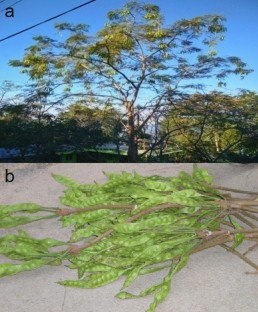Ethnic uses of Parkia timoriana (Fabaceae) and their significance to the Lotha tribes of Nagaland, North east India
Ovung Etsoshan Y., Loya Baanu, Brearley Francis Q., Tripathi S. K.
Research Articles | Published: 29 January, 2021
First Page: 77
Last Page: 85
Views: 4349
Keywords: Ecological services, Human health, Parkia timoriana , Socio-economic benefits, Traditional uses
Abstract
This work highlights the ethnic uses of Parkia timoriana and their significance for livelihoods, ecological and human health. The study was conducted through interviews and surveys in three villages of Wokha district, Nagaland, North-east India and revealed that Parkia is one of the most widely used, ethno-botanically important multipurpose tree species for the people of this region. The pods from the trees are one of the costliest vegetable in the area. Besides economic importance, its nutritional and medicinal value is highly indispensable. In addition, it also binds and prevents soil erosion from heavy rainfall through its wide crown in shifting cultivation fallows. We find that villagers are well aware of the role of Parkia from a socio-economic point of view and are establishing plantations of this species; however, their perception regarding ecological benefits is less well developed. We recommended to continue promotion of Parkia species in this region to maximize the socio-economic and ecological benefits in the future, but note the recent reports on die-back diseases that need attention for timely management interventions.

References
- Angami T, Bhagawati R, Touthang L, Makdoh B, Nirmal, Lungmuana, Bharati KA, Silambarasan R, Ayyanar M (2018) Traditional uses, phytochemistry and biological activities of Parkia timoriana (DC.) Merr., an underutilized multipurpose tree bean: a review. Genet Resour Crop Evol 65:679–692
- Anon J (2013) Parkia roxburghii (yongchak) an alternative to rubber. DoLR’s Commun 8:12–14
- Devi NL, Das AK (2010) Plant species diversity in the traditional home gardens of Meitei community: a casestudy from Barak Valley, Assam. J Trop Agric 48:45-48
- Devi TP, Shakuntala I, Devi G, Nonglait KKL, Singha LB, Pattanayak A, RahamanH (2007) Antibacterial, nematicidal and nutritional properties of different parts of tree bean, Parkia roxburghii (G. Don). Asian J Microbiol Biotechnol Environ Sci 9:621–625
- Devi NL, Singha D, Das AK (2019) Phenology of deciduous tree species in traditional Meitei homegardens of Barak valley, Assam, northeast India. Trop Plant Res 6(3):365–375
- Devi NL, Singha D, Tripathi S (2020) Phenology, population structure and carbon sequestration potential of Parkia timoriana, a heirloom tree in traditional Meitei homegarden of Northeast India. Vegetos 33:222–228
- Elangbam P, Singh SG (2020) Economic and environmental sustainability of Parkia timoriana, a tree bean. In: Singh R, Ramaraj R, Kanchand, Kumar J, Singh A, Chowdhary D (eds) Proceedings of second international conference on global initiatives for sustainable development: issues and strategies. Anu Publishing, Meerut, Uttar Pradesh, India, p 64–72
- Firake DM, Venkatesh A, Firake PD, Behere GT, Azad Thakur NS (2013) Parkia roxburghii: an underutilized but multipurpose tree species for reclamation of jhum land. Curr Sci 104:1598–1599
- Gopi R, Singh S, Raj C (2019) Status of Fusarium diseases of crop plants in North East India. Indian Phytopathol 72:637–646
- Hopkins HCF (1994) The Indo-Pacific species of Parkia (Leguminosae: Mimosoideae). Kew Bull 49:181–234
- Kanjilal UN, Kanjilal PC, Das A (1938) Flora of Assam, vol II. Prabasi Press, Calcutta
- Kaur N, Singh J, Kamboj SS, Agrewala JN, Kaur M (2005) Two novel lectins from Parkia biglandulosa and Parkia roxburghii: isolation, physicochemical characterization, mitogenicity and anti-proliferative activity. Protein Pept Lett 12:585–595
- Kumar R, Tapwal A, Borah RK (2012) Identification and controlling Verticillium wilt infecting Parkia roxburghii seedlings in Manipur India. Res J For 6:49–54
- Longvah T, Deosthale YG (1998) Nutrient composition and food potential of Parkia roxburghii, a less known tree legume from northeast India. Food Chem 62:477–481
- Raj H, Borah RK, Yadav S (2017) Preliminary investigations of Parkia roxburghii decline in North East India. In: Ngachan SV, Prakash N, Sharma SK, Singh IM, Roy SS, Ningombam A, Punitha P, Ansari MA, Singh KR, Sailo B, Singh TB, Sonia C, Anand YR, Singh TS, Singh YS (eds) National Symposium on Emerging and Re-emerging Plant Diseases in North East India: Challenges and Strategies. Umian, Meghalaya, India: ICAR Research Complex for NEH Region, p 88
- Saha R, Tomar JMS, Ghosh PK (2007) Evaluation and selection of multipurpose tree for improving soil hydro-physical behaviour under hilly eco-system of north east India. Agrofor Syst 69:239–247
- Salam JS, Khuman MS, Singh MP (1995) The oil of Parkia roxburgii G. Don, a potential insecticide. Curr Sci 68:502
- Sathya A. Siddhuraju P (2015) Effect of processing methods on compositional evaluation of underutilized legume, Parkia roxburghii G. Don (yongchak) seeds. J Food Sci Technol 52:6157–6169
- Singh MK (2019) Potential of underutilized legume tree Parkia timoriana (DC.) Merr. in eco-restoration of jhum fallows of Manipur. J Pharmacogn Phyochem 8:1685–1687
- Singh AR, Dutta SK, Singh SB, Boopathi T, Lungmuana, Saha S, Dayal V, Akoijam R, Sharma SK, Singh NH (2018) Occurrence, severity and association of fungal pathogen, Botrydiplodia theobromae with sudden death or decline of tree bean (Parkia timoriana, (DC.) Merr) in North Eastern India. Curr Sci 115:1133–1142
- Singh NS, Tripathi SK (2019) Ethnomedicinal and ecological importance of Parkia timoriana (DC.) Merr. in North-east India. In: Tripathi SK, Upadhyaya K, Hedge N (eds) Medicinal Plants of India: Conservation and Sustainable Use. Today and Tomorrow’s Printers and Publishers, New Delhi, pp 283–292
- Sprent JI, Ardley J, James EK (2017) Biogeography of nodulated legumes and their nitrogen-fixing symbionts. New Phytol 215:40–56
- Suvachittanont W, Kurashima Y, Esumi H, Tsuda M (1996) Formation of thiazolidine-4-carboxylic acid (thioproline), an effective nitrite-trapping agent in human body, in Parkia speciosa seeds and other edible leguminous seeds in Thailand. Food Chem 55:359–363
Author Information
Department of Forestry, Mizoram University, Aizawl, India